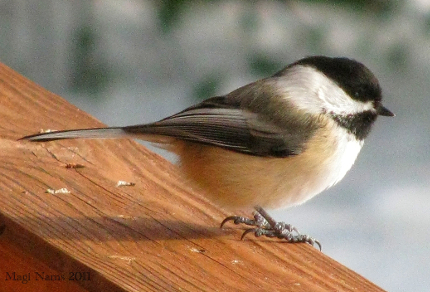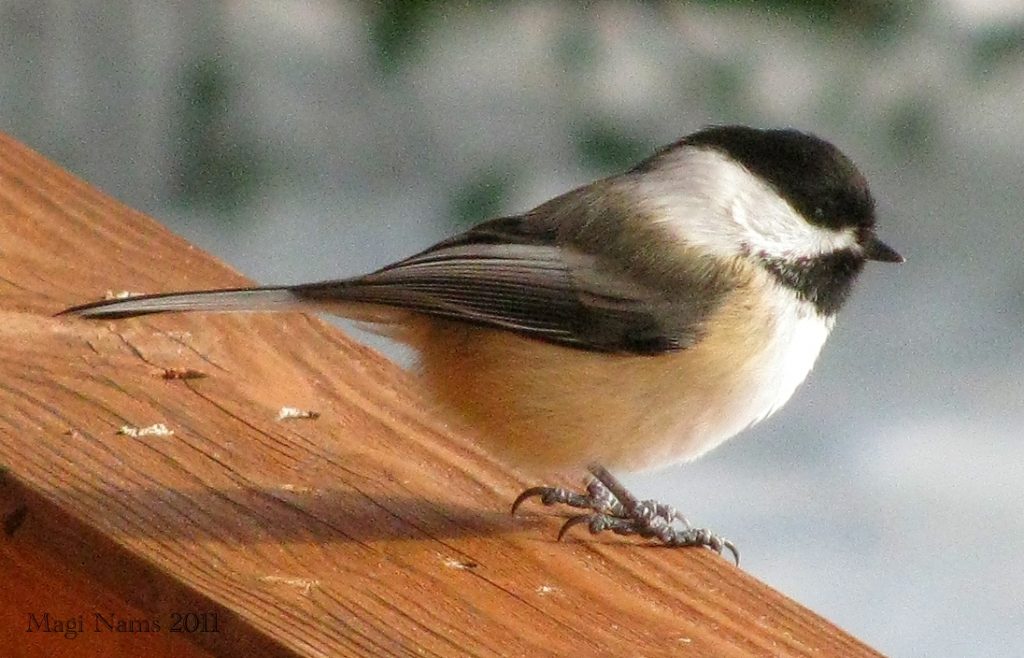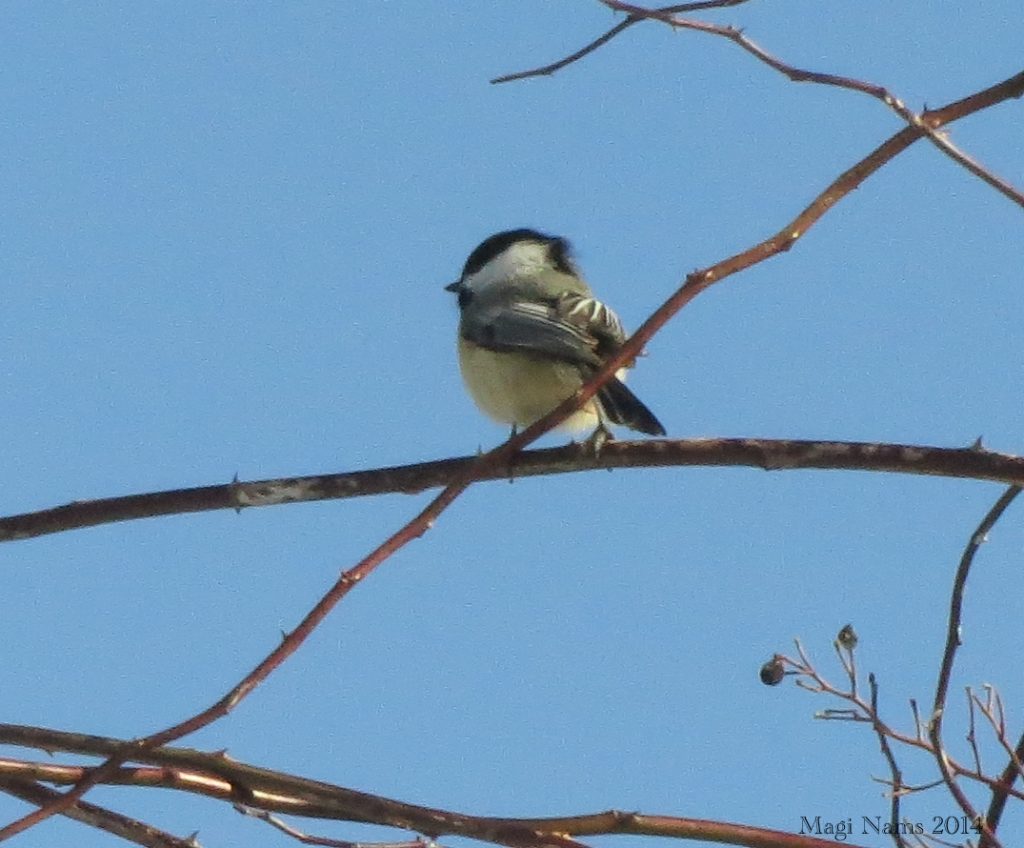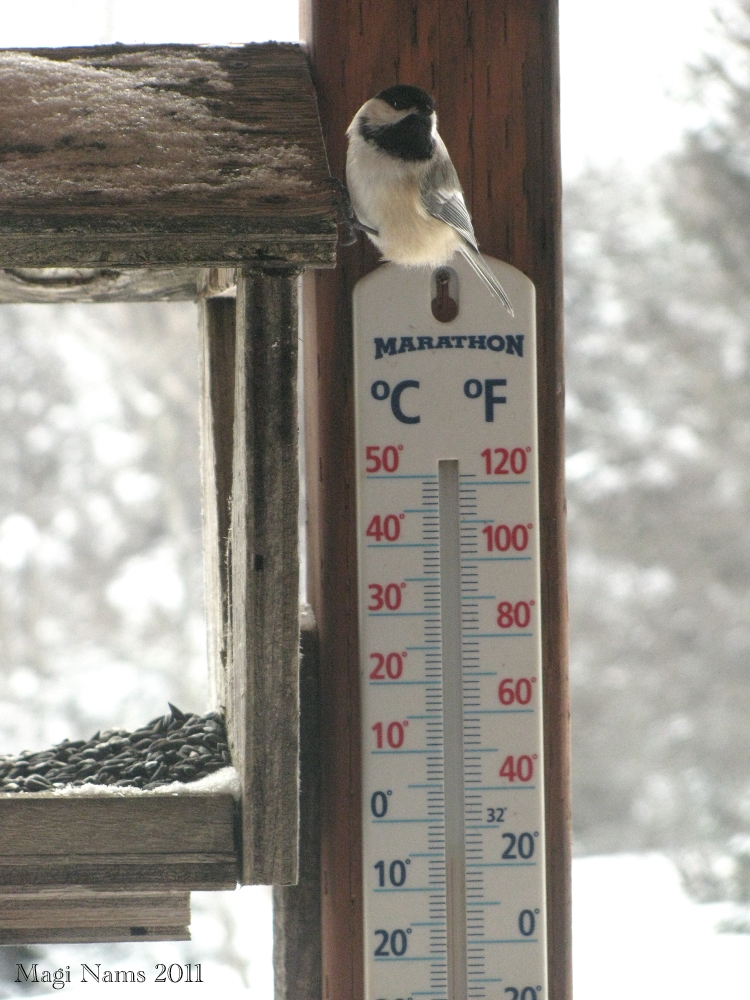Perky, inquisitive and confiding, the black-capped chickadee is one of North America’s best known and loved avian species.
This week’s featured bird is the black-capped chickadee, Poecile atricapillus. Black-capped chickadees personify cheerfulness as they poke into bark crannies in search of insect eggs or pluck seeds from weeds and feeders. “Who ever saw a dejected Chickadee?” wrote W. Earl Godfrey, author of The Birds of Canada.1
The black-capped chickadee is a small, chunky bird with a big head, small beak and long tail. It has a black “bib” and prominent black cap over a broad, white cheek patch. Its back, wings and tail are grey, and its sides, buff-coloured. This species has a total body length of 12-15 centimetres and weighs 9-14 grams.2 Males and females are coloured alike. Like other chickadees and titmice, the black-capped chickadee belongs to the songbird family Paridae.
Black-capped chickadees occur year-round in forests and shrublands across North America, from Alaska to Newfoundland, from tree line in the north to mid-America.2 They travel in small groups called “companies” and forage in a variety of habitats that include deciduous and mixed forests, willow and alder thickets, forest clearings and edges, yards, parks and weedy fields.1
Perky and ever-curious, black-capped chickadees fly their undulating flight pattern directly to our feeder from the shelter of spruce and pine windbreaks near our house. On their arrival at the feeder, they cling to the roof or walls while scanning the area for danger. After determining that the coast is clear, they hop down onto the feeder platform and snatch up black oil sunflower seeds in their tiny beaks. Then they wing back to the cover of the conifers.
Even when out of sight, black-capped chickadees divulge their presence with bright “chicka-dee-dee-dee” calls. Here in Nova Scotia, they begin whistling two-note mating calls in January,when the province is still in the throes of winter. A young friend once asked, “Magi, what’s the cheeseburger bird? I keep hearing this bird singing ‘cheeseburger’.” His mystery bird was a black-capped chickadee, whose mating call sounds like a bright “CHEESE-burger!”
After mating, a pair of black-caps excavates or remodels a hole in a tree as a nesting site. The female lays her eggs within the cavity and incubates them. The male feeds her while she incubates. After the eggs hatch, both parents procure food for their rapidly-growing young.3
In 2009, while birding for the Maritime Breeding Bird Atlas, I heard muted yet insistent cries of young birds emanating from somewhere. I spotted an adult black-capped chickadee carrying an insect larva or caterpillar in its beak. The chickadee perched on a branch and studied me for several minutes. It must have decided I wasn’t a threat because it flew to a snag in a shallow wetland and entered a hole in the dead tree’s trunk. As it did so, the decibel level of the young birds’ cries rocketed. I’d found an active chickadee nest.
Here in Nova Scotia, winter temperatures bounce up and down like a yo-yo. Wild storms periodically fling cold and freezing rain, as well as snow, onto the landscape. In his conservation classic, A Sand County Almanac, Aldo Leopold wrote, “I suspect that in the chickadee Sunday School two mortal sins are taught: thou shalt not venture into windy places in winter, thou shalt not get wet before a blizzard’.”4 Our black-capped chickadees appear to have learned their lessons well.
References:
1. W. Earl Godfrey. The Birds of Canada. 1979. National Museum of Natural Sciences, Ottawa, pp. 277-278.
2. The Cornell Lab of Ornithology. All About Birds. Black-capped Chickadee. Life History. Retrieved March 10, 2017. https://www.allaboutbirds.org/guide/Black-capped_Chickadee/lifehistory
3. Paul R. Ehrlich, David S. Dobkin, and Darryl Wheye. The Birder’s Handbook: A Field Guide to the Natural History of North American Birds. 1988. Simon and Schuster Inc., New York, p. 424.
3. Aldo Leopold. A Sand County Almanac. 1978 edition. Ballantyne Books, New York, p. 96.
*Portions of this post appeared in an earlier post.








Best wishes, your Spring not too far away. Pat.
Hello, Pat! Wonderful to receive your comment all the way from Grahamstown! Yes, spring is on its way, and with it, the air will once more be filled with birdsong. I’m working on my South Africa book and mentally hearing your raucous hadeda ibises and the soothing whistles of red-winged starlings. South Africa is definitely a birder’s paradise. Best wishes to you and Mary.